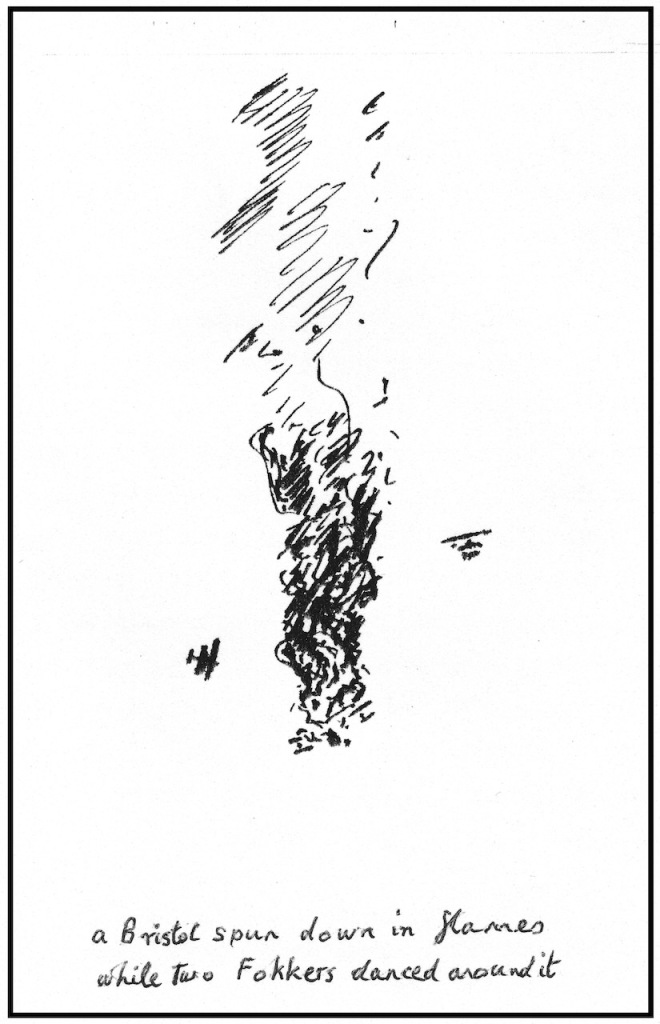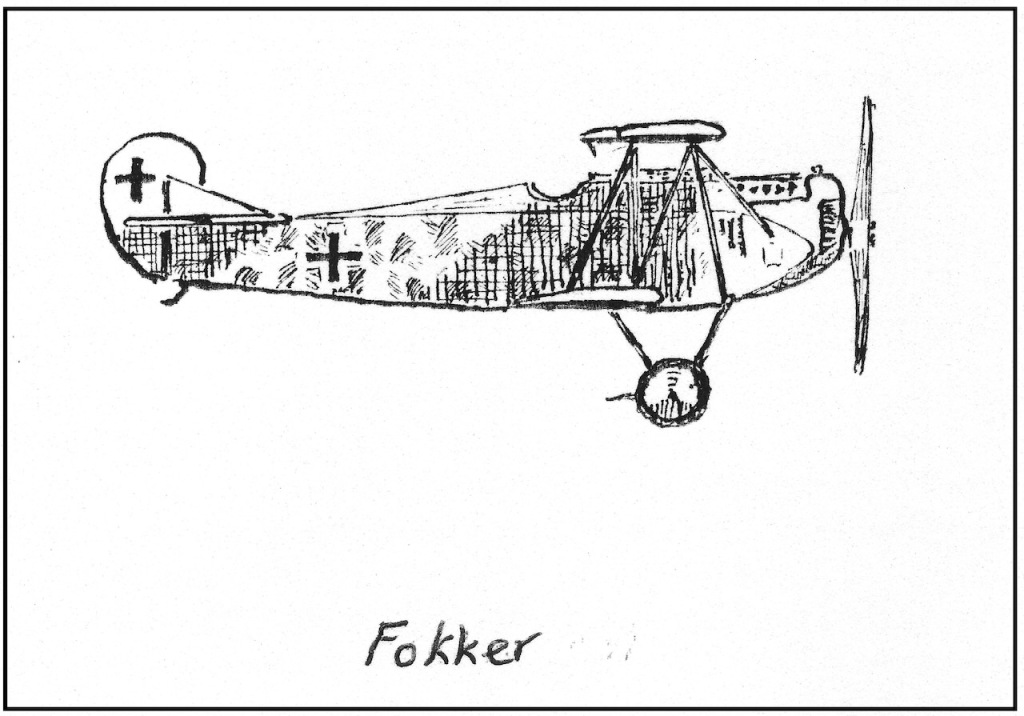After a few days in a pilots’ pool I was posted to 20 Squadron on a little grass field near a village, Boisdinghem, not far from St. Omer. After a few local flights round the vicinity I did my first Offensive Patrol (OP) with an NCO observer. The logbook reads:
Cpl Newlands1 – 120min – 14,000’ – Comines Ypres Bailleul. Bombed Comines. Separated from formation, no scraps.
‘Separated from the formation’ recalls vivid memories: throttle hard against the stop, every nerve and thought concentrated on getting more power and speed and climb and, despite all your efforts, the formation drawing further ahead and further above. It was the experience of every new boy. To find and destroy enemy aircraft rather than be destroyed by them, the leader needed all the height he could get. If a straggler filled the role of bait well and good, and if he was seen being cut off by enemy fighters the leader would probably turn and go down on them. It was a hard life.
After that trip I was taken on by an experienced observer whose pilot had been posted home. Jones2 was an almost fearless man whose aim was to shoot down German aircraft. I never knew his Christian name or where he came from or whether he had a family, but as far as we did know each other we knew and trusted each other completely. Except for a fortnight when he was on leave, we flew together till his death six weeks later. He was not a gregarious man: I was the nearest to a friend he had in the squadron, but we never talked of anything but our work, of flying and fighting tactics, and how to do it better. He had a hot, potentially violent temper and no one pulled his leg much in the mess. I was very happy to have him behind me and I think he was glad to fly with me. It is a natural law, to do with the need to hope, that an observer believes he has an exceptionally good pilot.
The squadron consisted of A, B and C flights of six aircraft each, with a few more in ‘workshop reserve’. Aircraft missing or crashed were replaced the same day, or the next, from an ‘Aircraft Park’ somewhere further back. There were eighteen crews, each of a pilot and observer, with more available from a pool in the back areas. The ready replacement of casualties to men and aircraft is a very important factor in morale. The Commanding Officer was Major Johnstone3, a British born South African. He had a medical disability that should have precluded him altogether from flying, and in fact he did not fly regularly. Sometimes he would take a newly-posted observer and act as bait for the formation but he never led the squadron: yet it was Johnstone who held the squadron together when things were grim. He had done a tour of flying duty earlier in the war and had a Military Cross. He had the wisdom, firmness and a light touch to restore our spirits when we were having a bad time with the German fighters. His character infused the squadron. With him, as Recording Officer (adjutant), was Captain A.T. Packham, another South African, an old friend of Johnstone’s and a strong and loyal supporter. They were a fine pair.
Every evening, when orders arrived from Wing, the CO, Packham and the flight- commanders sat down together and worked out the next day’s flying programme. This included the names of the crews to fly and was pinned up in the messes – officers’, sergeants’ and men’s. Normally we provided three offensive patrols, usually of nine aircraft each, but sometimes of sixteen, so it was very seldom that a crew was required for three patrols in a day and, depending on the weather, they were often only required for one. We were a fighter squadron and our purpose on offensive patrols was to find and destroy German aircraft; and since at that time the Germans seldom came across the lines in fighting strength, it was on their side of the lines that we patrolled. Usually each Bristol Fighter carried one 112 pound bomb, and the formation was given a bombing target, some rail or road junction or a suspected headquarters, rest area or ammunition dump: but it was clearly understood that our object was fighting and that if we met EA (Enemy Aircraft) before we reached our bombing target we were to let our bombs go, if we had crossed the lines, and get on with it. The bombing was only intended as an irritant and to cause pressure to be put on the German commander to order his fighters to engage us. We carried no bombsights: the procedure was to lean out as far as you could and when the target disappeared under the leading edge of the bottom plane you counted to six and then pulled the plug – regardless of whether we were at twelve or eighteen thousand feet or flying up or down wind, or across it. If we needed to hit something, the only method was to go down to a couple of hundred feet; and even then that needed training, which we did not have. Anyway, bombing was not our job.
The intention behind our strategy was to give cover, direct and indirect, to our artillery observation and reconnaissance aircraft on both sides of the lines and to prevent the enemy’s spotter and recce aircraft from working. There were two obvious tactical disadvantages to our policy: by using our aircraft to maintain continuous patrols throughout the day we allowed the Germans to concentrate when they chose and to engage us in superior numbers: and because were always operating on the other side of the lines a forced landing caused by engine failure or by enemy action usually meant capture. Probably our worst handicap was the prevailing westerly wind, which in a dogfight drifted us further and further from our lines, so that unless the Huns broke off the fight they would be on our tails when we were forced to turn for home: but for all the disadvantages I think the policy of maintaining the offensive on the enemy side of the lines was the right one at the time, while the enemy lacked the will or the means to stop us.
Sometimes, instead of seeking a bombing target, one or two of the formation would carry vertical cameras and we would be given pin-points to photograph or be ordered to take a line strip of mosaic. This involved flying a steady course and speed and, with nine of us drifting along at eighty mph at about 15,000’, the German AA gunners used to plaster us. We left behind us a long dark cloud of archie bursts merging together. If there was a layer of alto-stratus or cirrus above us they could see us better and it was worse. I think their AA shells were badly designed and burst into fragments mostly too small to do vital damage. The fabric covering of wings and fuselage were often riddled with small holes; and occasionally pilots and observers were slightly wounded by fragments that only barely penetrated their heavy flying clothing; but we did not lose any aircraft to AA fire. It could make things uncomfortable and noisy even though the exhaust pipes of the earlier Bristols ended two or three feet ahead of the pilot’s head: later when we were issued with machines fitted with long exhaust pipes, which acted as silencers, the shell bursts sounded much closer and more dangerous. On the first flight with long pipes we were dismayed at the fearsome improvement in the Germans’ shooting.
Excerpt from The Memoirs of Thomas Cathcart Traill, ch.7: 20 Squadron. Ypres/Bailleul. pp. 46-48
- Possibly: Corporal [later Sergeant Mechanic] A. Newland ↩︎
- Percy Griffith Jones ↩︎





